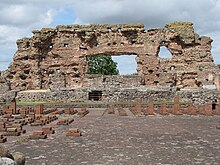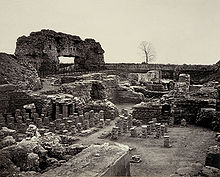Viroconium Cornoviorum
 Remains of the public baths, known as "The Old Work" | |
| Location | Wroxeter, Shropshire, England |
|---|---|
| Region | Britannia |
| Type | Settlement |
Viroconium or Uriconium, formally Viroconium Cornoviorum, was a Roman town, one corner of which is now occupied by Wroxeter, a small village in Shropshire, England, about 5 miles (8.0 km) east-south-east of Shrewsbury. At its peak, Viroconium is estimated to have been the 4th-largest Roman settlement in Britain, a civitas with a population of more than 15 000.[1] The settlement probably lasted until the end of the 7th century or the beginning of the 8th.[2] Extensive remains can still be seen.
Name
Viroconium is a Latinised form of a toponym that was reconstructed as Common Brittonic *Uiroconion "[city] of *Uirokū". *Uirokū (lit. "man-wolf") is believed to have been a masculine given name meaning "werewolf".[3][4]
The term "Cornoviorum" distinguishes the site as the Viroconium "of the Cornovii", the Celtic tribe whose civitas the settlement became. The original site of the Cornovian capital (also thought to have been named *Uiroconion) was a hillfort on the Wrekin.
History
Roman

Viroconium was established in about AD 58 as a castra for the Legio XIV Gemina during their invasion of Roman Wales. They were later replaced by the Legio XX Valeria Victrix until the fortress was abandoned by the military around AD 88 and taken over by the civilian settlement that had grown up around the fort. By 130, it had expanded to cover an area of more than 173 acres (70 ha). It then had many public buildings, including thermae and a colonnaded forum dedicated to Hadrian as shown by the remains of an inscription. Simpler temples and shops have also been excavated. At its peak, Viroconium is estimated to have been the fourth largest Roman settlement in Britain with a population of more than 15,000.[1]
Middle Ages
Following the end of Roman rule in Britain around 410, the Cornovii seem to have divided into Pengwern and Powys. The later minor Magonsæte sub-kingdom of the Angles emerged in the area when Oswiu conquered Pengwern in 656.
Viroconium may have served as the early sub-Roman capital of Powys. The city has been variously identified with the Cair Urnarc[5] and Cair Guricon[6] which appeared in the Historia Brittonum's list the 28 civitates of Britain.[7]
Town life in Viroconium continued in the fifth century, but many of the buildings fell into disrepair. Between 530 and 570, when most Roman urban sites and villas in Britain were being abandoned,[8] there was a substantial rebuilding programme. The old basilica was carefully demolished and replaced with new timber-framed buildings on rubble platforms. These probably included a very large two-storey building and a number of storage buildings and houses. In all, 33 new buildings were "carefully planned and executed" and "skillfully constructed to Roman measurements using a trained labour force".[9] Who instigated this rebuilding programme is not known, but it may have been a bishop.[10] Some of the buildings were renewed three times, and the community probably lasted about 75 years until, for some reason, many of the buildings were dismantled.[11]
The site was probably abandoned peacefully in the second half of the seventh century or the beginning of the eighth.[12] The court of Powys is believed to have moved to Mathrafal sometime before 717 following famine and plague in its original location.
Reuse of building stone
According to archaeologist Philip A. Barker, the parish churches of Atcham, Wroxeter, and Upton Magna are largely built of stone taken from the buildings of Viroconium Cornoviorum.[13]
Wroxeter Roman City

Some remains are still standing, and further buildings have been excavated. These include "the Old Work" (an archway, part of the baths' frigidarium and the largest free-standing Roman ruin in England) and the remains of a baths complex. These are on display to the public and, along with a small museum, are looked after by English Heritage under the name "Wroxeter Roman City". Some of the more important finds are housed in Rowley's House Museum in Shrewsbury. Most of the town still remains buried, but it has largely been mapped through geophysical survey and aerial archaeology. A reconstructed Roman villa was opened to the public on 19 February 2011[14] to give visitors an insight into Roman building techniques and how the Romans lived.[15] A Channel 4 television series, Rome Wasn't Built in a Day,[16] showed how it was built using authentic ancient techniques. The builders were assisted by a team of local volunteers and supervised by archaeologist Dai Morgan Evans, who designed the villa.
Literature
- A. E. Housman referred to the town as "Uricon" in his poem "On Wenlock Edge" in A Shropshire Lad.
- Wilfred Owen saw archaeological digs in progress at Wroxeter and referred to it in his 1913 poem "Uriconium: an Ode".[17]
- "Viroconium" is a poem by the Shropshire novelist and poet Mary Webb.[18]
- Viroconium in its latter days is featured in Rosemary Sutcliff's 1961 historical novel Dawn Wind, part of her Roman-Britain series following the descendants of the lead character from The Eagle of the Ninth.
- Viroconium features in Mary Stewart's Merlin Chronicles The Crystal Cave, The Hollow Hills and The Last Enchantment.
Notes
- ^ a b Frere, Britannia, p.253
- ^ White, Roger; Dalwood, Hal (March 1995). "Archaeological assessment of Wroxeter, Shropshire" (PDF). The Archaeology Data Service. p. 5. Retrieved 15 April 2016.
The occupation in the town seems to have ended peacefully, possibly in the late 7th or early 8th century
- ^ Delamarre, Xavier (2012). Noms de lieux celtiques de l'europe ancienne. Arles: Editions Errance. p. 273. ISBN 978-2-87772-483-8.
- ^ Wodtko, Dagmar (2000). Wörterbuch der keltiberischen Inschriften: Monumenta Linguarum Hispanicarum, Band V.1. Reichert-Verlag. p. 452. ISBN 978-3-89500-136-9.
- ^ Newman, John Henry & al. Lives of the English Saints: St. German, Bishop of Auxerre, Ch. X: "Britain in 429, A. D.", p. 92. James Toovey (London), 1844.
- ^ Ford, David Nash. "The 28 Cities of Britain" at Britannia. 2000.
- ^ Nennius (attrib.). Theodor Mommsen (ed.). Historia Brittonum, VI. Composed after AD 830. Template:La icon Hosted at Latin Wikisource.
- ^ Loseby, Simon T. (2000). "Power and towns in Late Roman Britain and early Anglo-Saxon England". Sedes regiae (ann. 400–800). Barcelona. p. 339.
The likes of Verulamium and Wroxeter... are the best representatives of a 'post-Roman' phase of activity on town sites, a phenomenon which is not attested beyond the middle of the fifth century elsewhere.
{{cite book}}: Invalid|ref=harv(help); Unknown parameter|editors=ignored (|editor=suggested) (help)CS1 maint: location missing publisher (link) - ^ Barker 1998, pp. 121–128.
- ^ Barker 1998, p. 125.
- ^ Barker 1998, p. 136.
- ^ Archaeological assessment of Wroxeter, Shropshire
- ^ Barker, A. Philip (1977). Techniques of Archaeological Excavation. Routledge. p. 11.
- ^ BBC News Shropshire – Reconstructed Roman villa unveiled at Wroxeter
- ^ English Heritage – Properties
- ^ Daily Mail: "Channel 4 series build Roman villa using ancient methods"
- ^ Uriconium An Ode | The Wilfred Owen Association
- ^ Representative Poetry Online – Mary Webb : Viroconium
References
- Aston, Michael; Bond, James (1976). The Landscape of Towns. Archaeology in the Field Series. London: J.M. Dent & Sons Ltd. pp. 45–48, 51–54. ISBN 0-460-04194-0.
- Anderson, J. Corbet. The Roman City of Uriconium at Wroxeter, Salop. – Illustrative of the History and Social Life of Our Romano-British Forefathers. London: J. Russell Smith, 1867.
- Atkinson, Donald. British Archaeological Society: Report on the Excavations at Wroxeter (the Roman City of Viroconium) in the County of Salop, 1923–1927. Oxford: Oxford University Press, 1970.
- Barker, Philip, Ed. Wroxeter Roman City: Excavations 1966–1980. London: Her Majesty's Stationery Office, 1980.
- Barker, Philip, and Webster, Graham. From Roman Viroconium to medieval Wroxeter: recent work on the site of the Roman city of Wroxeter. Worcester: West Mercian Archaeological Consultants, 1990. ISBN 0-9516274-1-4
- Barker, Philip, and White, Roger. Wroxeter Roman City (English Heritage Guidebooks). Swindon, Wilts.: English Heritage, 1999. ISBN 1850746982
- Barker, Philip; White, Roger; Corbishley, Mike (1998). The Baths Basilica, Wroxeter: excavations 1966–90. Swindon: English Heritage. ISBN 1850745285.
- Bushe-Fox, J. P. Excavations on the Site of the Roman Town at Wroxeter, Shropshire, in 1912 (Society of Antiquaries of London. Research Committee. Report no. 1). Oxford: Society of Antiquaries, 1913.
- Bushe-Fox, J. P. Excavations on the Site of the Roman Town at Wroxeter, Shropshire, in 1913: Second Report (Society of Antiquaries of London. Research Committee. Report no. 2). Oxford: Society of Antiquaries, 1915.
- Bushe-Fox, J. P. Excavations on the Site of the Roman Town at Wroxeter, Shropshire, in 1914: Third Report (Society of Antiquaries of London. Research Committee. Report no. 4). Oxford: Society of Antiquaries, 1916.
- De la Bedoyere, Guy. (1991). The Buildings of Roman Britain.
- Ellis, Peter. The Roman Baths and Macellum at Wroxeter. Swindon, Wilts.: English Heritage, 2000. ISBN 978-1-85074-606-5
- Ellis, Peter, and White, Roger. 'Wroxeter Archaeology Excavation and Research on the Defences and in the Town – 1968–1992.' in Transactions of the Shropshire Archaeological and Historical Society, Vol. 78. Shrewsbury, Shrops.: Shropshire Archaeological Society, 2006. ISBN 0-9501227-8-5
- Fox, George E. A Guide to the Roman City of Uriconium at Wroxeter, Shropshire. Wellington, Shrops.: Shropshire Archaeological Society, 1927.
- Frere, S. S. Britannia: a History of Roman Britain. London: Routledge & Kegan Paul Ltd., 1987. ISBN 0-7102-1215-1
- Gaffney, V. L., and White, R. H. (2007). 'Wroxeter, the Cornovii, and the Urban Process: Final Report on the Wroxeter Hinterland Project 1994–1997', Journal of Roman Archaeology Supplementary Series, No. 68.
- Jackson, Kenneth (1970). "An Appendix on the Place Names of the British Section of the Antonine Itinerary". Britannia. 1.
- Kenyon, Kathleen M. Excavations at Viroconium, 1936–1937. Shrewsbury, Shrops. Shropshire Archaeological Society, 1937.
- Rivet, A. L. F., and Smith, Colin. (1979). The Place-Names of Roman Britain.
- Urban, Sylvanus. 'The Roman City of Uriconium.' Gentleman's Magazine and Historical Review, 1859. 206: 447–458.
- Webster, Graham. The Cornovii. London: Sutton, 1991. ISBN 0-86299-877-8
- Webster, Graham. The Legionary Fortress at Wroxeter: Excavations by Graham Webster, 1955–1985. Swindon, Wilts.: English Heritage, 2002. ISBN 9781850746850
- Webster, Graham. The Roman Army. London: Grosvenor Museum, 1973. ISBN 0-903235-05-6
- Webster, Graham, The Roman Imperial Army: Of the First and Second Centuries A.D. Norman: University of Oklahoma Press, 1998. ISBN 0-8061-3000-8
- Webster, Graham, and Barker, Philip. Viroconium, Wroxeter Roman City. London: Her Majesty's Stationery Office, 1966 & 1978. ISBN 0-11-670323-7
- White, Roger H.; Barker, Philip (1998). Wroxeter: Life and Death of a Roman City. Tempus. ISBN 978-0-7524-1409-6.
{{cite book}}: Invalid|ref=harv(help) - White, Thomas. A Guide to the Ruins of Uriconium, at Wroxeter, Near Shrewsbury. Kessinger Publishing, 2009, ISBN 978-1-120-28973-5. BiblioBazaar, 2010, ISBN 978-1-143-79640-1. Nabu Press, 2010, ISBN 978-1-143-63705-6
- White, Thomas. Uriconium; A Historical Account of the Ancient Roman City, and of the Excavations Made Upon Its Site, at Wroxeter, in Shropshire. General Books, 2010. ISBN 1152210491
External links
- BBC: Architectural Heritage
- Wroxeter Roman City: English Heritage
- Teachers'Resource pack on Wroxeter: English Heritage
- Viroconium Cornoviorum: Roman Legionary Fortress, British Tribal City – Roman-Britain.org
- Roman Fort and Bridge, Wroxter, Shropshire – Roman-Britain.org
- Wroxeter – Roman Britain's Fourth Largest City: Article by Dr. Gareth Evans
- Excavation report by Thomas Wright
- 1859 Article from Gentleman's Magazine
- Wroxeter, the Cornovii, and the Urban Process
- Report on Uriconium: Archaeological assessment of Wroxeter, Shropshire
- Esmonde Cleary, A., R. Warner, R. Talbert, T. Elliott, S. Gillies. "Places: 79741 (*Viroconium)". Pleiades. Retrieved 8 March 2012.
{{cite web}}: CS1 maint: multiple names: authors list (link)
- 50s establishments in Roman Britain
- English Heritage sites in Shropshire
- Archaeological sites in Shropshire
- Ruins in Shropshire
- History of Shropshire
- Roman towns and cities in England
- Visitor attractions in Shropshire
- Former populated places in Shropshire
- Sub-Roman Britain
- Museums in Shropshire
- Museums of Ancient Rome in the United Kingdom
- Archaeological museums in England
- Roman legionary fortresses in England

